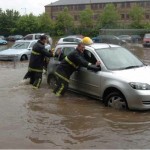Background
In last month’s issue of this magazine, we published a Report on “Climate Change Adaptation in Ireland: A Blueprint Without a Builder,” digesting recent studies by the Irish Climate Analysis and Research UnitS (ICARUS) at the Department of Geography, National University of Ireland, Maynooth. These and other studies, funded by the Irish EPA, have developed the data and analysis in the Republic of Ireland that can serve as the foundation for a concrete, realistic adaptation plan. Unfortunately, the Irish government has failed to utilise what exists and has left us hanging in the winds that are blowing harder and harder. The Northern Ireland government offers an equally ineffectual adaptation plan.
The recently published Northern Ireland [NI] Climate Change Adaptation Programme has a history that offered possibilities. It had its genesis in the UK Climate Change Act 2008 that led to the UK Climate Change Risk Assessment (CCRA) (2012), which also produced A climate change risk assessment (CCRA) for Northern Ireland (January 2012). Much of this work was undertaken by agencies before considerable backtracking on all things environmental from the present Conservative-led coalition government.
The NI climate Risk Assessment, produced by the UK consultants with input from local stakeholders, provided a thorough and concrete analysis of the climate impacts that NI can expect to experience over the coming decades. The process and evidence used for the Assessment was transparent and it has given us a clear view of what we can expect, much of which is driven by changes in water resources, precipitation/flooding, and pressures on natural species.
NI can expect milder winters with fewer deaths, but hotter summers with more deaths. Tourism will be boosted and extended by warmer summers, but negatively impacted by lower water supplies in the summer and flooding from extreme events. Some crops, like grass and wheat, and some forestry will increase, but water shortages and flooding will offset some of these gains. NI’s remarkable diversity of species and habitats will suffer from climate change, including threats from pests and diseases. NI businesses, predominately smaller (less than 500 employees) than in UK, typically do not have the insurance coverage or resources to recover from extreme weather events or to adapt quickly to changing climate impacts. The NI geographical location is isolated with longer supply routes. There is widespread social deprivation, and the highest level of fuel poverty in the UK, and many of these vulnerable populations live in areas at greatest risk from extreme weather events.
Now that we have a pretty good idea of what is coming, here was an opportunity for the NI government to take the next step and tell us what we specifically need to do to prepare for these climate changes.
That is not what we got.
The Report
When a government report starts out with a “roadmap” and a “programme” founded on 5 “themes,” 5 “objectives,” 3 “principles,” a “framework” and 4 “primary areas for action,” and each area (flooding, water, natural environment, and agriculture and forestry) has from 5 to 7 “high level actions” each of which has a number of “key activities”, you know you have entered a bureaucratic bog that not even the strongest wellies will save you from. Unfortunately that is where you find yourself on reading the NI Climate Adaptation Programme.
The first half of the report simply restates some general knowledge about climate change and summarizes what we already learned from the NI Climate Change Risk Assessment. This preliminary material might have been useful to some with little or no knowledge about climate change. In Chap 4, where the NI Risk Assessment is reviewed, there are several sidebars, including one on “Fact sheet for businesses,” describing an initiative between DOE and Climate Northern Ireland that developed notes to guide small and medium businesses on how to deal with insurance, supplies, ICT and other impacts from climate change. Another addressed structural changes made at a water treatment works to protect against future damages from increased rainfall from climate change. These examples leaped out, not because of the green background, but because here were two concrete adaptation actions that were actually taken. They demonstrated what is possible.
Unfortunately, the specificity of these actions served to underline the lack of anything concrete when we got to the actual Adaptation Programme where the language reverted to vague abstractions.
The “Vision” of this Programme promised to identify “the initial set of actions and activities that will contribute to making Northern Ireland more resilient to a changing climate over the next five years and beyond.” At 43-44. Unfortunately what we got is not action or activities, but plans for more planning or a commitment to continue what is already being done.
The mantra throughout is that such and such a department “will continue” to do what it is already doing. The verbal construction “will continue” is used over 30 times in the report.
For instance, the NI CCRA expressly acknowledges that there are significant gaps in data and evidence needed to help NI to develop adaptation actions. What does the Programme promise? Objective 4 of the Roadmap/Vision lays out the “action” of “Seeking to address evidence gap in CCRA for Northern Ireland.” At 46. There are no ideas, let alone concrete steps on how, where, when this will happen, who will do it, and no idea on what the cost will be and where funds are to come from.
One almost gets a sense that something might be about to happen when the report describes the Cross-Departmental Working Group on Climate Change (CDWG CC). A Sub Group took the 130 risks and opportunities identified in the NI CCRA, ranked them, and selected 1/3 as the focus for this first Adaptation Programme, and organised this limited list into four Primary Areas: flooding, water, natural environment, agriculture and forestry. This work was followed by a workshop for Departments, then an external stakeholder consultation which led to a report by the NGO Climate Northern Ireland that was submitted to the Department of the Environment. Climate NI led the stakeholder consultation process over four months and in its Summary Report for the government it reinforced a number of key actions for an effective adaptation plan, and stressed that “All stakeholders emphasized the need for government leadership to stimulate them to act,” including in areas of green procurement and building regulations. All of this seemed transparent and offered the possibility that something concrete would result.
Unfortunately, once again, when we look closely at the sections on the four “Primary areas for action,” there is little on offer. Take the section on “Flooding.” There is a lot more about departments continuing to do what they are already doing. The one actual step that offered some hope of real action was the plan, already required under the EU Floods Directive, for the government to produce flood risk and hazard maps as that is an obvious critical tool. Yet there is little analysis of how the flood maps will be used to assure adaptation to climate change. One would expect that the flood maps would be critical to any planning system but the only mention of planning in relation to adaptation is a proposed new policy for development in proximity to reservoirs. There is no discussion of the need for or any commitment to limit development in areas of flood risks, or in areas of sea level rise on coastal communities. Concrete steps and hard decisions are missing at the core of this Programme.
The analyses for the other Primary Areas for action — water, natural environment, and agriculture and forestry —are equally vague and unhelpful. For agriculture the focus is on how to take advantage of the benefits from climate change, such as increased yields, new crops, longer growing seasons. The report proclaims that there are few severe negative consequences for agriculture. But the report is largely silent about the negative climate consequences from agriculture. There is only a passing reference to the climate change problems that will be aggravated by any growth in the agriculture sector, especially the increase in methane emissions. The report barely mentions, and certainly fails to address, how NI will manage its obligations to reduce greenhouse gases (GHG) while it greatly expands agriculture and methane emissions.
For forestry the report merely asserts that there will be a working towards this, or a looking at that, or some aim to determine some measure or another. Nothing we can hang our hats on, or hold the agencies responsible for failing to do.
Finally there are brief sections on “Governance, delivery and reporting on progress,” and “Building adaptive capacity and addressing climate change.” In the later section, there is some useful information on the work of Climate NI. There is also a general reference to EU sources of funding, but again it is already existing programs, like CAP, that are simply re-branded as possible funding sources for adaptation projects.
Conclusion: Branding More Than Substance
What we said in regard to the Republic of Ireland’s Adaptation Framework is equally applicable to NI’s Adaptation Programme:
The point is that there is a wealth of concrete material that could have, should have, informed the government’s Adaptation Framework. Like all of us, the general public and policy-makers need examples, models and encouragement to face the challenges of adaptation. Making the implications of the Framework specific and concrete would have advanced progress toward adaptation. The Framework falls far short of marking any progress.
See “Ireland’s Climate Adaptation Strategy: The Emperor Has No Clothes On.”
Instead we have been offered a re-branding of work in progress under pre-existing obligations from the EU or UK. The clear signal that there is no concrete adaptation action offered here is the lack of any substantive discussion or analysis of the costs of adaptation.
Copenhagen Adaptation Plan
We should not accept any excuses that developing climate adaptation is very hard. We need look only at other, more proactive, administrations to see what is possible, for example the City of Copenhagen adaptation plan or “6 of the World’s Most Extensive Climate Adaptation Plans.” What is needed is the political will and commitment by the government to take its climate responsibilities more serious and to encourage and support the talented staff of the environmental and other agencies to do what they know how to do.
As Climate NI argued: “All stakeholders emphasized the need for government leadership to stimulate them to act.” We are still waiting.
Sources
Northern Ireland Department of the Environment, Northern Ireland Climate Change Adaptation Programme (January 2014).
www.doeni.gov.uk/climate_change_adaptation_programme.htm
UK Climate Change Risk Assessment (CCRA) (January 2012). www.doeni.gov.uk/uk_climate_change_risk_assessment_government_report-2.pdf
A climate change risk assessment (CCRA) for Northern Ireland (January 2012). www.doeni.gov.uk/climate_change_risk_assessment_ni_2012.pdf
Summary of Northern Ireland CCRA Report (2012). www.doeni.gov.uk/summary_of_northern_ireland_climate_change_risk_assessment_report.pdf
Climate Northern Ireland, Climate Change: Northern Ireland Adaptation Programme – Stakeholder Summary Report (October 2012).
Climate Northern Ireland, Adapting to Climate Change: An introduction for Public Sector policy makers, resource managers and practitioners (November 2012).
www.climatenorthernireland.org.uk/cmsfiles/resources/files/1840348–CLIMATE-BOOKLET.pdf
Climate Northern Ireland, What Can I Do To Prepare For Climate Change: Case Studies (November 2012). www.climatenorthernireland.org.uk/cmsfiles/CaseStudies/NI-Case-studies-Info-Sheet.pdf
“Ireland’s Climate Adaptation Strategy: The Emperor Has No Clothes On,” Reports section of irish environment magazine (February 2013). www.irishenvironment.com/reports/irelands-climate-adaptation-strategy-the-emperor-has-no-clothes-on/
Maria Gallucc, “6 of the World’s Most Extensive Climate Adaptation Plans,” inside climate news (20 June 2013). insideclimatenews.org/news/20130620/6-worlds-most-extensive-climate-adaptation-plans
Copenhagen Climate Adaptation Plan (October 2011). subsite.kk.dk/sitecore/content/Subsites/CityOfCopenhagen/SubsiteFrontpage/LivingInCopenhagen/ClimateAndEnvironment/ClimateAdaptation/~/media/296A647A55724670B3117307D4B626C6.ashx





No comments yet, add your own below